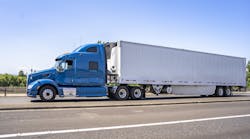Composites offer several advantages for final mile distributions
In recent years, the whole concept of moving materials has shifted, led by companies like Amazon and Walmart. Many traditional coast-to-coast truck journeys have been replaced with shorter drives between the major hubs and local distribution centers, leading to an increase in final mile distributions between distribution centers and end customers in urban areas. Now, the transportation industry must develop smaller, more flexible vehicles that are suited to cope with this changing demand. Let’s explore how using composites can help the American trucking industry respond to changing customer behavior.
In vans, trucks, and tractor-trailers, swapping out steel and aluminum vehicle parts—such as side walls, crossmembers, roof bows, door frames, and panel assemblies—with composite parts provides several key advantages for the U.S. trucking industry. These include weight savings, improved corrosion resistance, and improved design options.
Composites outperforming metals
The weight savings are particularly beneficial after recent hikes in fuel prices, particularly diesel, as this results in increased fuel efficiency and lower overall fuel costs for businesses. For example, in May 2022, one gallon of diesel cost an average of over $5.50, which is over two dollars higher than the previous year and the highest average monthly price in decades. The fuel market is not the only area where volatile pricing impacts the transportation industry, with the metal market also subjected to instability in recent years. This has created an environment where manufacturers using large quantities of steel or aluminum do not know exact prices or lead times in advance of ordering, causing operational disruptions and impacting margins.
Of the available composites solutions that can be used for parts in place of metals, such as vehicle side walls and crossmembers, fiberglass is most commonly used because of its relatively low price providing a weight reduction of 10% to 20%. Even more weight savings, in the range of 50% to 60%, can be achieved using carbon fiber while also improving mechanical capabilities. Although this is a more expensive alternative to metals, it can be desirable in applications requiring high stiffness, with carbon fiber boasting a stiffness of roughly 40% more than aluminum. Hybrid composites are a good compromise, providing weight reductions of roughly 35% while matching the stiffness of aluminum.
Composites have a better corrosion resistance than metals such as steel or aluminum. Generally, metals require extra coatings, such as hot-dip galvanization using zinc, to provide corrosion resistance, but these wear off over time and add to ongoing maintenance costs. Composites are optimized for corrosion resistance and don’t require additional coatings, and the associated lifetime maintenance costs, to withstand their harsh operating environments.
Furthermore, composite materials are more aesthetically flexible than steel or aluminum, with a wider variety of finish possibilities available, so customers can choose between having a product that is glossy, matte, rubberized, or even metallic in appearance. The metallic finish is popular because composites are often used as replacements for metal parts in existing structures and this allows them to blend in visually. There are also more color options with composites without the need for additional painting, meaning composite profiles can be produced to match a delivery firm’s existing brand guidelines with fewer steps.
Benefits of pultrusion
Reinforced fiberglass composites made using continuous manufacturing processes, such as pultrusion, are well suited for use in vehicle bodies because these processes are designed for high-volume production, ensuring consistent production quality batch-to-batch and highly repeatable results. This helps to ensure pultruded composite solutions are made in the most cost-effective way possible.
In the pultrusion manufacturing method, strands of glass or carbon fibers, mats or technical fabrics are pulled together, saturated with resin, and then pulled into guides which feed into a heated die to cure the composite. The new composite is then cut to the specified length, or even spooled in longer continuous lengths (for rods or flats). Pultrusion also offers high flexibility in the profile design and size. For example, profiles over 36” wide can be pultruded, great for side panels or other long surfaces as they can be cut to any length, avoiding partition lines, highly visible and unaesthetic, typical of other non-continuous manufacturing processes.



